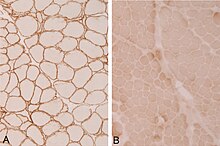Limb–girdle muscular dystrophy
[11] Usually, the hip girdle is the first area to exhibit weakness,[2] manifesting as difficulty walking, going up and/or down stairs, rising from a chair, bending at the waist, or squatting.[16] HMG CoA Reductase homozygous mutation leads to a form of LGMD that may respond to treatment with the downstream metabolite mevalonolactone in the cholesterol synthesis pathway.[4] The 2014 Evidence-based guideline summary: Diagnosis and treatment of limb–girdle and distal dystrophies indicates that individuals suspected of having the inherited disorder should have genetic testing.[6] Also in the differential are Emery–Dreifuss muscular dystrophies, Pompe disease, later-onset congenital myasthenic syndromes, and proximal-predominant hereditary motor neuropathies.[25] In terms of the prognosis of limb–girdle muscular dystrophy in its mildest form, affected individuals have near-normal muscle strength and function.LGMD isn't typically a fatal disease, though it may eventually weaken the heart and respiratory muscles, leading to illness or death due to secondary disorders.[26] The prevalence of individual LGMDs, as studied in the United States, in descending order, are those due to mutation of 1) calpain, 2) dysferlin, 3) collagen VI, 4) sarcoglycans, 5) anoctamin 5, and 6) fukutin-related protein.[3] With the new definition, several diseases were removed from the LGMD category: There is a variety of research under way targeted at various forms of limb–girdle muscular dystrophy.[28] According to a review by Bengtsson et al. some success with AAV-mediated gene therapies (for different disorders) have increased interest in researchers, with CRISPR/Cas9 and exon-skipping helping these therapeutic goals along[29].



SpecialtySymptomsDiagnostic methodDifferential diagnosisDuchenneBeckerfacioscapulohumeralEmery-DreifussPompe diseasecongenital myasthenic syndromemotor neuropathymuscular dystrophiesmuscle wastingautosomalinheritancestatinsHMG-CoA reductaseshoulder girdleones located in the faceskeletal musclescardiac musclepalpitationsPseudoathletic appearancemuscle hypertrophypseudohypertrophymuscular mitochondrial impairmentheritabledominantrecessivebiopsygenetic testingImmunohistochemicalsarcoglycanopathiessarcoglycanElectrocardiographyautosomal dominantautosomal recessiveDNAJB6HNRPDLcalpainopathyBethlem myopathyCOL6A1COL6A2COL6A3Ullrich congenital muscular dystrophyCOL12A1TRIM32POMGNT1TRAPPC11POPDC3PYROXD1DystrophinopathiesDuchenne muscular dystrophyBecker muscular dystrophyFacioscapulohumeral muscular dystrophydifferentialEmery–Dreifuss muscular dystrophiescongenital myasthenic syndromeshereditary motor neuropathiesexercisePhysical therapyOccupationalRespiratorymyostatingene therapymyotonic dystrophiesfounder effectMyofibrillar myopathyEmery–Dreifuss muscular dystrophymitochondrial myopathyTOR1AIP1CRISPR/Cas9biomarkersprednisoneMuscle atrophyMedlinePlus EncyclopediaBibcodeDiseasesDBMedlinePluseMedicineGeneReviewsOrphanetMuscular dystrophyCongenitalDystrophinopathyBecker'sDistalMyotonicOculopharyngealMuscular Dystrophy AssociationMuscular Dystrophy CanadaMyotonic Dystrophy FoundationMuskelsvindfondenMDA Muscle WalkLabor Day TelethonDécrypthonGrøn KoncertStamulumab (MYO-029)muscleneuromuscular junctionneuromuscular diseaseNeuromuscular-junction diseaseautoimmuneMyasthenia gravisLambert–Eaton myasthenic syndromeNeuromyotoniaMyopathyLimb-girdle muscular dystrophy 1Distal (most)Limb-girdle muscular dystrophy 2FukuyamaUllrichWalker–WarburgdystrophinEmery–Dreifusscollagen diseasePTP diseaseX-linked MTMadaptor protein diseaseBIN1-linked centronuclear myopathycytoskeleton diseaseNemaline myopathyZaspopathyChannelopathyMyotonia